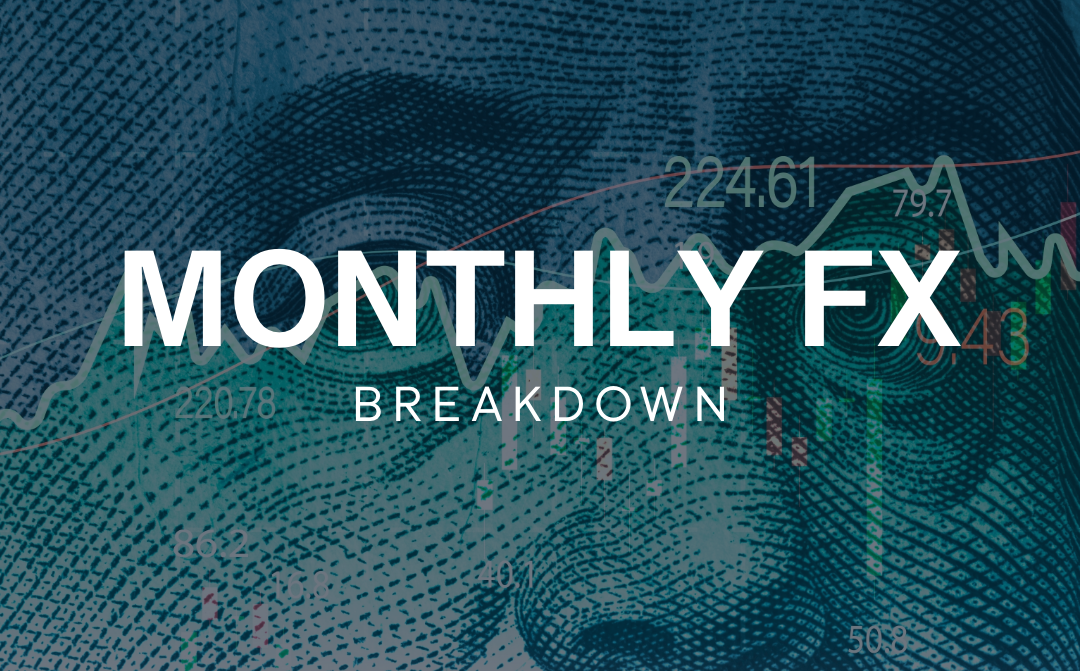Monthly FX Breakdown – November 2023

Table of Content
USD
A choppy month for the US dollar has seen the dollar index oscillate between the 105.5 and 107 levels. By and large, gains have been relatively short and sharp in nature, with much of the month dominated by gradual declines. This highlights the fearful nature of markets of late, with periods of confidence being treated with caution while market weakness brings sharp periods of upside for the dollar. Looking at the dollar’s performance against its peers, it has fared relatively well against the commodity currencies (CAD, NZD and AUD) as growth fears dent the outlook for demand. USDJPY also enjoyed a strong month, with the higher for longer Fed approach comes up against a BoJ that continues its accommodative stance. Meanwhile, The Swiss franc enjoyed a strong month, with the USDCHF providing the one notable area of weakness for the greenback.
October has seen the dollar enjoy some periods of haven demand, with a whole raft of elements for traders to be fearful of. Concerns around a resurgence in energy markets, economic weakness in the face of rising rates, geopolitical concerns in the middle east, and now market weakness around Q3 earnings season. On the economic front, strong US retail sales and GDP releases hammered home the relative strength of their economy compared with many of the other major developed nations. That does allow for another potential rate hike if necessary, with markets pricing in a 24% chance that they will hike in December. November looks to be off the table from that perspective, with the outlook likely to be key in setting sentiment going forward.
The role of earnings should continue as we move into the new month, although the impact of each company becomes less significant for the wider sector compared with those reporting early. Weakness from big tech names will be key, with any further downside likely to drive the dollar higher. Elsewhere, the decision to kick the can down the road with regards to a funding bill will come back to haunt investors, with Joe Biden and Janet Yellen now tasked with finding an agreement by the new deadline of 17 November. From an economic standpoint, any continuation of recent strong data out of the US would raise the pricing for a December hike, with commentary key to determining whether we are going to see that end of year rate rise from the Fed.
EUR
The euro has experienced an impressive month just gone, with the euro index pushing sharply higher over much of the month. That strength has come into question later into the month, with the final week of the month seeing the single currency come under pressure. From a currency specific basis, the euro managed to outperform their neighbours over the channel, with GBP, AUD, NZD, and CAD all losing significant ground against EUR. Once again it was the CHF which impressed, with EURCHF losing ground over the course of the month.
The strength of the euro came in the face of a weakening economic outlook, although it was the PMI release which appeared to be the turning point for the single currency. That report saw the eurozone services sector fall further into contraction territory, driven in part by the move from 50.3 to 48.0 in Germany. It was also the German CPI figure which helped ease concerns on the inflation side of the story, helping to drive the ECB into a rate pause which ended a run of 10 consecutive rate hikes. With the eurozone economy and inflation on a downward trajectory, are we due a reversal of the strength seen in early October?
Looking ahead, questions over the direction of the eurozone economy look set to dominate once again. The relative strength of the euro in October could leave it at risk of downside, especially if we see another sharp move lower for inflation. The ECB will no doubt be keen to turn the corner and cut rates when possible, but markets need to see considerable headway made on the push towards target inflation. The weakness evident throughout much of the economy does signal the potential for a swift move lower for inflation, but there are considerable risks that could derail those efforts. Most notably the potential for a rise in European energy prices if there is a cold winter. Thus, European gas prices will be notable over the coming months as a driver of inflation expectations and the euro.
GBP
A changeable month for the pound saw weekly shifts in sentiment with little clear direction overall on the GBP index. That outlook holds across many of its markets, with the pound struggling to see any particular traction in either direction. That puts it firmly in the middle of the pack, with sentiment around the currency having settled after a multi-month decline seen since the surprise August CPI decline.
While that August decline in headline inflation (6.8% from 7.9%) saw markets unwind their bullish bets, the subsequent readings have done little to further that disinflation story. Two subsequent CPI readings of 6.7% highlight the fact that the UK has a problem, and the average earnings figure of 8.1% is doing little to help things. While optimists will look towards the stability of UK PMI surveys as a sign that they are doing better than their neighbours on the growth-front, the Bank of England will likely want to see the economy weaken somewhat in a bid to drive down consumption and price pressures.
Looking ahead, any signs of economic weakness will help further the case for a prolonged pause from the Bank of England. However, with wage and inflation pressures continuing to prove stubbornly high, any signs of economic strength could see a slightly more hawkish tone from the Bank of England. The month of November kicks off with a BoE meeting, which is unlikely to bring any shift for now. However, the UK inflation issue remains somewhat that needs to change if the BoE are to maintain their neutral stance. Any hawkish shift or strong economic data could help lift the pound after months of weakness.
CAD
The Canadian dollar has been losing ground over much of the past month, with this key commodity currency on the slide against the likes of the US dollar, pound, euro, and Swiss franc. The flip side to this was a positive momentum against its fellow commodity currencies from Australia and New Zealand, while the Japanese yen continued to be an easy target as CADJPY pushed higher.
From an economic standpoint, there is a feeling that the impact of higher interest rates has started to feed through to consumers. The strength of the Ivy PMI survey (53.1) does highlight a relatively strong Canadian economy despite weakness in the manufacturing sector (47.5). The lack of any notable jump in unemployment would signal to the Bank of Canada that they could raise rates further if necessary. However, the latest decline in Canadian inflation cooled calls for another rate hike, with the BoC ultimately opting to leave rates steady with a hawkish bias. That data dependent approach will be in place across all banks, with the risk of a spike in energy prices providing them with a need to remain ready to act if necessary. The gains seen for crude in September failed to continue into October, with prices largely rotating between $80 and $90 for WTI. Interestingly, the potential gains for crude in the wake of the attack on Israel gave little upside for the Canadian dollar, which has been losing traction throughout recent weeks.
Looking ahead, the influence of energy markets should come into question once again, with the delayed Israeli offensive in Gaza likely to dominate over the coming weeks. Commentary over the potential for this to be a relatively drawn-out affair does highlight a potential environment that is supportive of energy prices. That could provide a tailwind for the CAD. Elsewhere, the questions remain over how much the Canadian economy will suffer under the weight of elevated rates, with additional signs of a cooling economy and inflation likely to drive additional CAD downside if it comes to fruition.
AUD
The Australian dollar saw plenty of choppiness over the course of October, although the overall trajectory saw this key commodity currency losing traction against a basket of currencies. However, the AUD only managed to gain traction against fellow commodity currencies AUD and CAD, losing ground against US and European currencies in particular.
Chinese concerns did ease somewhat over recent weeks, with sentiment for the Australian dollar stabilizing as a result. While China has had a tough time of it, the knock-on impact for economies such as Australia have been less notable than expected thus far. With the Chinese announcing plans to issue an additional one trillion yuan worth of special treasury bonds, sentiment around a potential fiscal boost should prove supportive for AUD going forward. With Australian inflation moving higher (5.6% from 5.2%), there remains a significant risk that we will see the RBA raise rates again in the future. While Bullock indicated that this CPI rise was largely expected, the rebound seen over the past two months does heighten the chance of additional action if the economy proves resilient enough.
Looking ahead, any further signs of elevated inflation and economic strength could drive expectations of another rate rise from the RBA. Considering the fact that RBA cash rate stands well below their peers (4.1%), there is a good chance that they could raise rates further if neccesary. With that in mind, economic data should be followed closely given the greater potential for a hawkish shift. Also watch out for any additional stimulus pledges from the Chinese, although there are also ongoing risks in China given the recent Country Garden debt default.
NZD
The New Zealand dollar proved to be the big loser in October, with the currency losing ground against every major currency over the course of the month. That consistent decline seen in the first three-weeks of the month did give way to a more stable end to the month, but the wider picture does highlight the potential for further downside to come.
Last month saw New Zealand inflation fall further than expected, with the annual figure of 5.6% coming in below the 6% seen in the second quarter. Meanwhile, the country voted to replace the Labour party, with a right leaning coalition coming into power. That raises questions over the direction of the economy, with the greater uncertainty serving to drive NZD lower. Dairy prices have been relatively supportive, with the 4.3% growth figure signalling a period of rapid gains unlike anything we have seen since early 2022. Nonetheless, the declining inflation outlook and concerns have been a significant determinant of NZD weakness.
The new coalition have pledged to do away with the dual mandate at the RBNZ, with the bank potentially dropping their employment concerns to focus on inflation. That would add greater importance to any future CPI data going forward. Whether that comes into play or not remains to be seen, with any commentary from the government or RBNZ around the topic likely to drive NZD volatility.
Disclaimer: This material is a marketing communication and shall not in any case be construed as an investment advice, investment recommendation or presentation of an investment strategy. The marketing communication is prepared without taking into consideration the individual investors personal circumstances, investment experience or current financial situation. Any information contained therein in regardsto past performance or future forecasts does not constitute a reliable indicator of future performance, as circumstances may change over time. Scope Markets shall not accept any responsibility for any losses of investors due to the use and the content of the abovementioned information. Please note that forex trading and trading in other leveraged products involves a significant level of risk and is not suitable for all investors.







